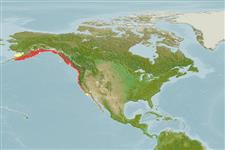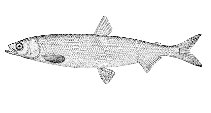Add your observation in Fish Watcher
| Native range | All suitable habitat | Point map | Year 2050 |

|
| This map was computer-generated and has not yet been reviewed. |
| Hypomesus pretiosus AquaMaps Data sources: GBIF OBIS |
Upload your photos and videos
Pictures | Videos | Google imageHypomesus pretiosus
Picture by Bull. U.S. Bur. Fish.
Pictures | Videos | Google imageHypomesus pretiosus
Picture by Bull. U.S. Bur. Fish.
Canada country information
Common names:
Day smelt, Kiina, Qaian
Occurrence: native
Salinity: brackish
Abundance: common (usually seen) | Ref: Clemens, W.A. and G.V. Wilby, 1961
Importance: commercial | Ref: Coker, G.A., C.B. Portt and C.K. Minns, 2001
Aquaculture: | Ref:
Regulations: restricted | Ref: Canadian Department of Fisheries and Oceans, 1995
Uses: live export: yes;
Comments: Recorded from the Pacific coast (Ref. 6885). In lower Fraser River and Pitt Lake, BC (Ref. 112251). Also Ref. 4925, 95148, 95155. In range Ref. 2850.
National Checklist:
Country Information: https://www.cia.gov/library/publications/resources/the-world-factbook/geos/ca.html
National Fisheries Authority: http://www.ncr.dfo.ca/home_e.htm
Occurrences: Occurrences Point map
Main Ref: Hart, J.L., 1973
National Database:
Occurrence: native
Salinity: brackish
Abundance: common (usually seen) | Ref: Clemens, W.A. and G.V. Wilby, 1961
Importance: commercial | Ref: Coker, G.A., C.B. Portt and C.K. Minns, 2001
Aquaculture: | Ref:
Regulations: restricted | Ref: Canadian Department of Fisheries and Oceans, 1995
Uses: live export: yes;
Comments: Recorded from the Pacific coast (Ref. 6885). In lower Fraser River and Pitt Lake, BC (Ref. 112251). Also Ref. 4925, 95148, 95155. In range Ref. 2850.
National Checklist:
Country Information: https://www.cia.gov/library/publications/resources/the-world-factbook/geos/ca.html
National Fisheries Authority: http://www.ncr.dfo.ca/home_e.htm
Occurrences: Occurrences Point map
Main Ref: Hart, J.L., 1973
National Database:
Common names from other countries
Classification / Names Common names | Synonyms | Catalog of Fishes(genus, species) | ITIS | CoL | WoRMS | Cloffa
Teleostei (teleosts) > Osmeriformes (Freshwater smelts) > Osmeridae (Smelts)
Etymology: Hypomesus: Greek, hypo = under + Greek,mesos = a half (Ref. 45335).
More on author: Girard.
Etymology: Hypomesus: Greek, hypo = under + Greek,mesos = a half (Ref. 45335).
More on author: Girard.
Environment: milieu / climate zone / depth range / distribution range Ecology
Marine; brackish; benthopelagic. Temperate; 61°N - 33°N, 163°W - 117°W
Distribution Countries | FAO areas | Ecosystems | Occurrences | Point map | Introductions | Faunafri
Eastern Pacific: Prince William Sound, Gulf of Alaska to Long Beach, southern California, USA. Reports from the western Pacific are misidentifications of Hypomesus japonicus.
Length at first maturity / Size / Weight / Age
Maturity: Lm ?, range 9 - ? cm
Max length : 30.5 cm TL male/unsexed; (Ref. 6885); common length : 15.0 cm TL male/unsexed; (Ref. 12193); max. reported age: 5 years (Ref. 72502)
Max length : 30.5 cm TL male/unsexed; (Ref. 6885); common length : 15.0 cm TL male/unsexed; (Ref. 12193); max. reported age: 5 years (Ref. 72502)
Short description Identification keys | Morphology | Morphometrics
Dorsal spines (total): 0; Dorsal soft rays (total): 9 - 11; Anal spines: 0; Anal soft rays: 12 - 17; Vertebrae: 64 - 67. Vomer small, without posterior process; periphery of glossohyal bone with single row of blunt teeth, a few teeth located irregularly at center of distal region; base of adipose fin less than 20% of head length; eye small; adipose eyelid well developed (Ref. 33312). Distinguished by its midlateral scale count of 66 to 73 and the presence of 4 to 7 pyloric caeca (Ref. 27547). Lateral line short and incomplete, reaching about to tip of pectorals (Ref. 27547). Adipose sickle-shaped; pectorals small; pelvic fins originating behind or below dorsal origin (Ref. 6885). Light olive green to brownish on back, sides and belly silvery and iridescent with a bright reflecting band along the side in living specimens; males show more golden hues than females during spawning season (Ref. 6885). Branchiostegal rays: 7-8 (Ref. 35792).
Individuals 3.5 cm may ascend rivers, presumably returning to the sea shortly after (Ref. 27547). Presumably young move offshore and reappear inshore as mature adults (Ref. 27547). At sea, they feed on small crustaceans, worms and jellyfish, as well as larval fishes (Ref. 6885, 10276). Females reach age 3, males age 2 (Ref. 27547). Oviparous, with demersal eggs and planktonic larvae (Ref. 35792). Eggs are laid on beaches with heavy surf action (Ref. 33312).
Life cycle and mating behavior Maturity | Reproduction | Spawning | Eggs | Fecundity | Larvae
Schools approach the beach to spawn, usually with the females appearing a few days before the males. At spawning, large numbers of males mill about near the edge of the surf. When a female is seen, numbers of males pursue her and try to get into spawning position. If she swims to deeper water, the males desert her. 1 to 5 males swim parallel to and slightly behind a ripe female. The males press against the female and as they reach water 2.5 to 5 cm deep, the fish bend and vibrate, releasing eggs and sperm, then retreat to deeper water. The spawning act may be repeated on several successive waves. Wave action buries the eggs, usually to a depth of 2.5 to10 cm but sometimes to as deep as 30 cm (Ref. 27547).
Main reference
Upload your references | References | Coordinator | Collaborators
Saruwatari, T., J.A. López and T.W. Pietsch, 1997. A revision of the ormerid genus Hypomesus Gill (Teleostei: Salmoniformes), with a description of a new species from the southern Kuril Islands. Species Diversity 2:59-82. (Ref. 33312)
Threat to humans
Harmless
Human uses
Fisheries: commercial; gamefish: yes
FAO(Fisheries: production; publication : search) | FishSource | Sea Around Us
More information
Population dynamics
Growth parameters
Max. ages / sizes
Length-weight rel.
Length-length rel.
Length-frequencies
Mass conversion
Recruitment
Abundance
Growth parameters
Max. ages / sizes
Length-weight rel.
Length-length rel.
Length-frequencies
Mass conversion
Recruitment
Abundance
Anatomy
Gill area
Brain
Otolith
Gill area
Brain
Otolith
Physiology
Body composition
Nutrients
Oxygen consumption
Swimming type
Swimming speed
Visual pigments
Fish sound
Diseases & Parasites
Toxicity (LC50s)
Body composition
Nutrients
Oxygen consumption
Swimming type
Swimming speed
Visual pigments
Fish sound
Diseases & Parasites
Toxicity (LC50s)
Human related
Aquaculture systems
Aquaculture profiles
Strains
Ciguatera cases
Stamps, coins, misc.
Aquaculture systems
Aquaculture profiles
Strains
Ciguatera cases
Stamps, coins, misc.
Tools
E-book | Field guide | Length-frequency wizard | Life-history tool | Point map | Classification Tree
| Catch-MSY |
Special reports
Download XML
Internet sources
Aquatic Commons | BHL | Cloffa | Websites from users | Check FishWatcher | CISTI | Catalog of Fishes(genus, species) | DiscoverLife | ECOTOX | Faunafri | Fishtrace | GenBank(genome, nucleotide) | GloBI | GOBASE | | Google Books | Google Scholar | Google | IGFA World Record | MitoFish | Otolith Atlas of Taiwan Fishes | PubMed | Reef Life Survey | Scirus | SeaLifeBase | Tree of Life | Wikipedia(Go, Search) | World Records Freshwater Fishing | Zoological Record
Estimates based on models
Preferred temperature (Ref. 115969): 7.5 - 11.8, mean 8.6 (based on 58 cells).
Phylogenetic diversity index (Ref. 82804): PD50 = 0.5313 [Uniqueness, from 0.5 = low to 2.0 = high].
Bayesian length-weight: a=0.00372 (0.00178 - 0.00775), b=3.17 (2.99 - 3.35), in cm Total Length, based on LWR estimates for this (Sub)family-body shape (Ref. 93245).
Trophic level (Ref. 69278): 3.4 ±0.41 se; based on food items.
Resilience (Ref. 120179): Medium, minimum population doubling time 1.4 - 4.4 years (tm=1-2; tmax=5; Fec=1,320).
Fishing Vulnerability (Ref. 59153): Low vulnerability (21 of 100).
Climate Vulnerability (Ref. 125649): High to very high vulnerability (71 of 100).




